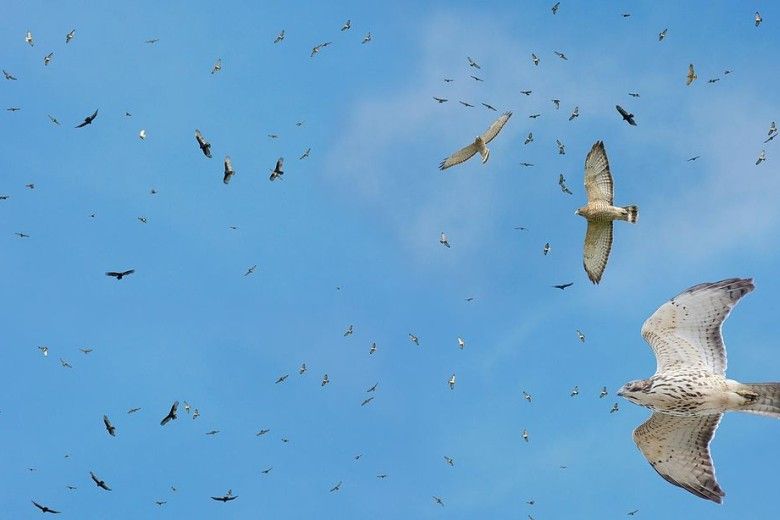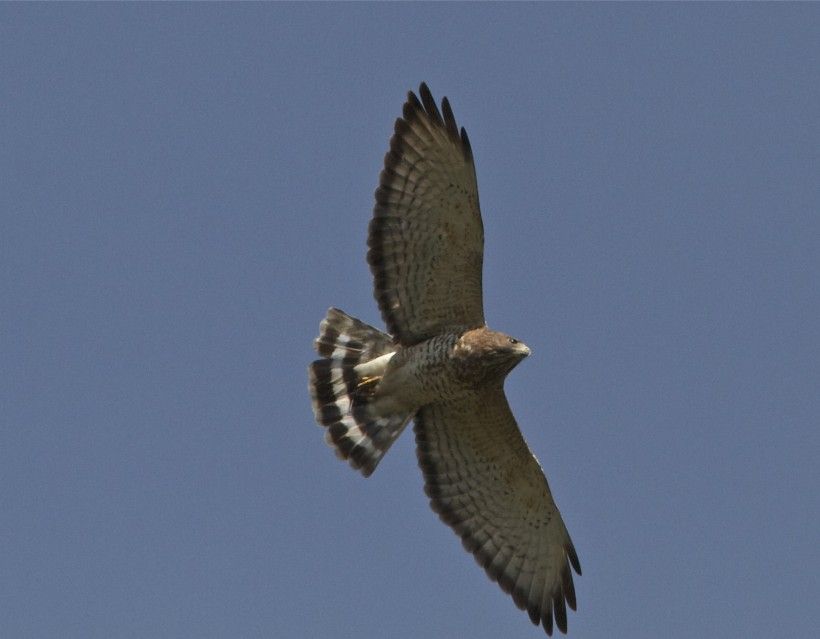September Spectacle: Broad-winged Hawk Migration

September brings shorter and cooler days as we approach the fall equinox. During this month a migratory spectacle takes place in our skies. Broad-winged hawks flock together in impressive numbers consisting of tens to thousands of individual birds as they fly south to their wintering grounds. These large flocks, called kettles, are an extraordinary sight.
How to Identify Broad-winged Hawks:

Why do these birds migrate together in such large numbers?
As these raptors find thermals (rising columns of air) and gather into kettles, they seem to attract even more broad-winged hawks. The sight of these kettles could be a type of avian communication signaling to other broad-winged hawks where thermals exist. Soaring on thermals is an efficient way for these birds to travel and catch prevailing winds south. Conserving energy by soaring and using less wing power is critical to their success in reaching wintering locations; often over 4,000 miles away in the neotropics.

Why do broad-winged hawks begin to migrate in September, earlier than most migratory hawks?
During September, the sun is still high enough in the sky to create updrafts and thermals necessary for broad-winged hawk migration. If they wait any longer, these thermals won’t be as strong or predictable. Broad-winged hawks are most likely observed migrating through our area during a two-week period occurring around mid-September when atmospheric conditions are at their peak for this species’ migration needs. Generally, broad-winged hawks do not build up fat storage for the trip, so conserving energy is critical. They will rest along the way in wooded areas and stop to hunt mammals, insects, reptiles, amphibians and sometimes small birds. These breaks and the use of less wing power by thermal soaring is vitally important to their successful migration.
The graphs below show the timing of Broad-winged Hawk Migration at Hawk Mountain:

Where are the best locations to observe kettles of broad-winged hawks in September?

Hawkwatch.org is a valuable resource and provides a search tool to find hawk watches to join. Two local spots to visit are Rose Tree Park in Media, Pennsylvania and Ashland Nature Center. They both will be holding hawk watches throughout this fall migration season.
Kevin Fryberger, Brandywine Conservancy’s Natural Resource Manager, has been recording bird sightings on ebird.org for over 20 years. This site has many tools to analyze data such as the below bar charts created for the Waterloo Mills and Laurels Preserves using Kevin’s broad-winged hawk observations:


Conservation and Research:
Deforestation is decreasing this species habitat. Broad-winged hawks benefit from land preservation, especially wooded areas. The Laurels and Waterloo Mills Preserves, accessible to members of the Brandywine Conservancy & Museum of Art, are both in regions designated as an Important Bird Area (IBA) by Audubon Pennsylvania. Click here for more information.
Researchers at Hawk Mountain are working on a Broad-winged Hawk Project. Individual birds are equipped with tracking devices, and with the use of satellite telemetry, maps can be created to track their movements and migration routes.
Individuals can help researchers learn more about broad-winged hawks just by looking up in September. Citizen scientists provide valuable data by logging observations through eBird and iNaturalist. The more we know and discover about this mighty migrant the more we can do to help conservation efforts for broad-winged hawks.
For more information on broad-winged hawks visit these sites:
https://www.allaboutbirds.org/guide/Broad-winged_Hawk/overview
https://www.audubon.org/field-guide/bird/broad-winged-hawk
https://birdsna.org/Species-Account/bna/species/brwhaw/introduction
http://www.hawkmountain.org/science/hawk-mountain-raptorcount/hawk-count~default.aspx
https://www.hmana.org/